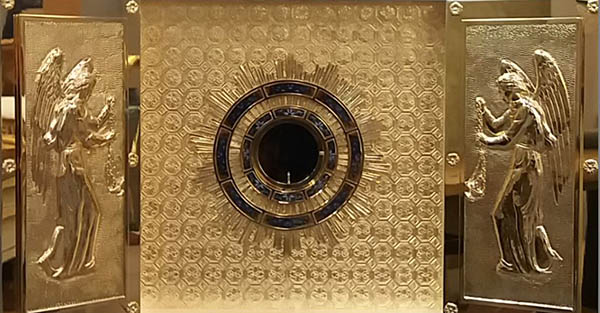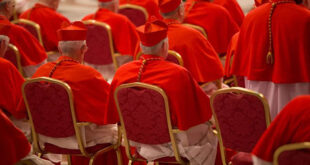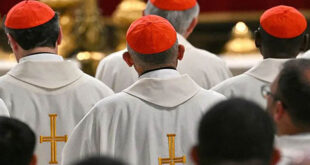The Tabernacle is one of the most significant and venerated elements within Catholic churches. This small “temple” or tabernacle, where the Blessed Sacrament is reserved, is a place of prayer and recollection that has played a central role in the lives of Catholics since the early centuries of the Church. To fully understand its importance, let’s explore its history, theological relevance, and practical applications for our daily lives.
What is the Tabernacle?
The Tabernacle, also known as the Sacred Tabernacle, is a sacred receptacle typically found on the main altar of Catholic churches. Its primary function is to guard the Eucharist: the consecrated bread that, according to Catholic faith, is the Body of Christ present in sacramental form. When we enter a church and see a small red light lit near the altar, it is a sign that Jesus is present in the Tabernacle, waiting for us in silence and humility.
The History of the Tabernacle
The history of the Tabernacle goes back to the early days of Christianity, although its form and significance have evolved over time. In the beginning, early Christians would keep the Eucharist in their homes to be able to commune in times of persecution when gathering in churches was dangerous. With the legalization of Christianity in the Roman Empire in the fourth century, the practice of reserving the Blessed Sacrament in churches began to develop, a gesture that expressed both reverence and precaution to prevent desecration.
In the Middle Ages, the Tabernacle became a fixed and highly visible structure in churches, often richly decorated as a symbol of the kingship of Christ. Its presence was a constant reminder that Jesus was truly present—a key concept in Eucharistic devotion.
During the Council of Trent in the sixteenth century, the Church reaffirmed the belief in the real presence of Christ in the Eucharist, thus giving a new impetus to the practice of adoration of the Blessed Sacrament. The reservation of the Eucharist in the Tabernacle, surrounded by great reverence and symbolism, was definitively established in the liturgical tradition of the Catholic Church.
Theological Significance of the Tabernacle
The Real Presence of Christ
The doctrine of the Real Presence holds that Christ is fully and truly present in the Eucharist. When a Catholic enters a church and stands before the Tabernacle, they are in the presence of Christ himself—in body, blood, soul, and divinity. It is not a symbol or mere reminder; the Church firmly believes in a substantial and living presence of Jesus. This belief forms the foundation of devotion to the Tabernacle and is the reason why Catholics often genuflect when passing in front of it.
A Place of Encounter and Dialogue
The Tabernacle also symbolizes Jesus’ desire to remain with us, as he said in the Gospel: “I am with you always, to the end of the age” (Matthew 28:20). His permanence in the Tabernacle is a tangible expression of this faithful love. From this perspective, the Tabernacle becomes a place of intimate encounter, where the faithful can present themselves as they are before Christ, who welcomes and listens to them. It is a place for silence, personal prayer, and inner peace.
Practical Applications: How to Incorporate Devotion to the Tabernacle into Daily Life
1. Visits to the Blessed Sacrament
Making a visit to the Blessed Sacrament is a Catholic tradition that consists of spending a few minutes before the Tabernacle, whether in a local church or an adoration chapel. It doesn’t need to be a long visit; what matters is the disposition of the heart. When we pause to pray before the Tabernacle, we can ask for our needs, give thanks for the blessings received, and, above all, let ourselves be loved by God.
2. Reflection and Inner Silence
In such a noisy and hectic world, the Tabernacle is an invitation to stop and reconnect with God. Spending time in silence before the Tabernacle helps to cultivate inner peace and serenity. This quiet space can be used to reflect on our lives, ask forgiveness for our mistakes, and renew our strength to continue on our path of faith. The peace experienced at the Tabernacle becomes an antidote to the anxieties of modern life.
3. Offering Our Daily Life as a Constant Adoration
Eucharistic adoration is not limited to perpetual adoration chapels; it can also be lived in daily life. Inspired by the presence of Jesus in the Tabernacle, we can offer every action, every work, and every moment of our day as a prayer of adoration to God. This attitude transforms our daily life into an “altar” where Christ dwells and sanctifies everything we do.
4. Practicing Reverence and Devotion
Each time we visit a church, making a genuflection or bowing before the Tabernacle is a way to express our faith in the Real Presence of Jesus. This small gesture is a declaration of respect and humility, a reminder that we are in the presence of something greater than ourselves. Practicing these acts of reverence in our daily lives helps keep our faith alive and reminds us that, at every moment, God is with us.
5. Sharing the Value of the Tabernacle with Others
Talking about devotion to the Tabernacle with friends, family, and loved ones is also a way of evangelizing. Faith is not something that should be hidden, and sharing how this devotion helps us can inspire others to draw closer to the Tabernacle and find comfort and strength in its presence.
Relevance of the Tabernacle in Today’s Context
Today, devotion to the Tabernacle may seem outdated to some. However, in a time marked by individualism, anxiety, and a lack of purpose, this devotion becomes a refuge for the soul. Modern society, with all its comforts, still cries out for peace and meaning. In this context, the Tabernacle offers an answer: a deep and silent communion with God himself. The Tabernacle reminds us that we are not alone, that Christ remains with us, and that our lives find meaning and fulfillment in Him.
Conclusion
The Tabernacle is much more than a liturgical object or a tradition; it is the beating heart of the Catholic faith. Its presence in our churches calls us to rediscover, time and again, that God remains with us in every moment and that we can turn to Him in any circumstance of our lives. Each visit to the Tabernacle is an opportunity for encounter, peace, and adoration. It is a reminder that, amid the daily hustle and bustle, we can always find a place of refuge and rest in Christ.
Thus, the Tabernacle is not just a place for Sundays or special moments but a constant presence that transforms our faith and our lives, inviting us to live every day in communion with Jesus.






